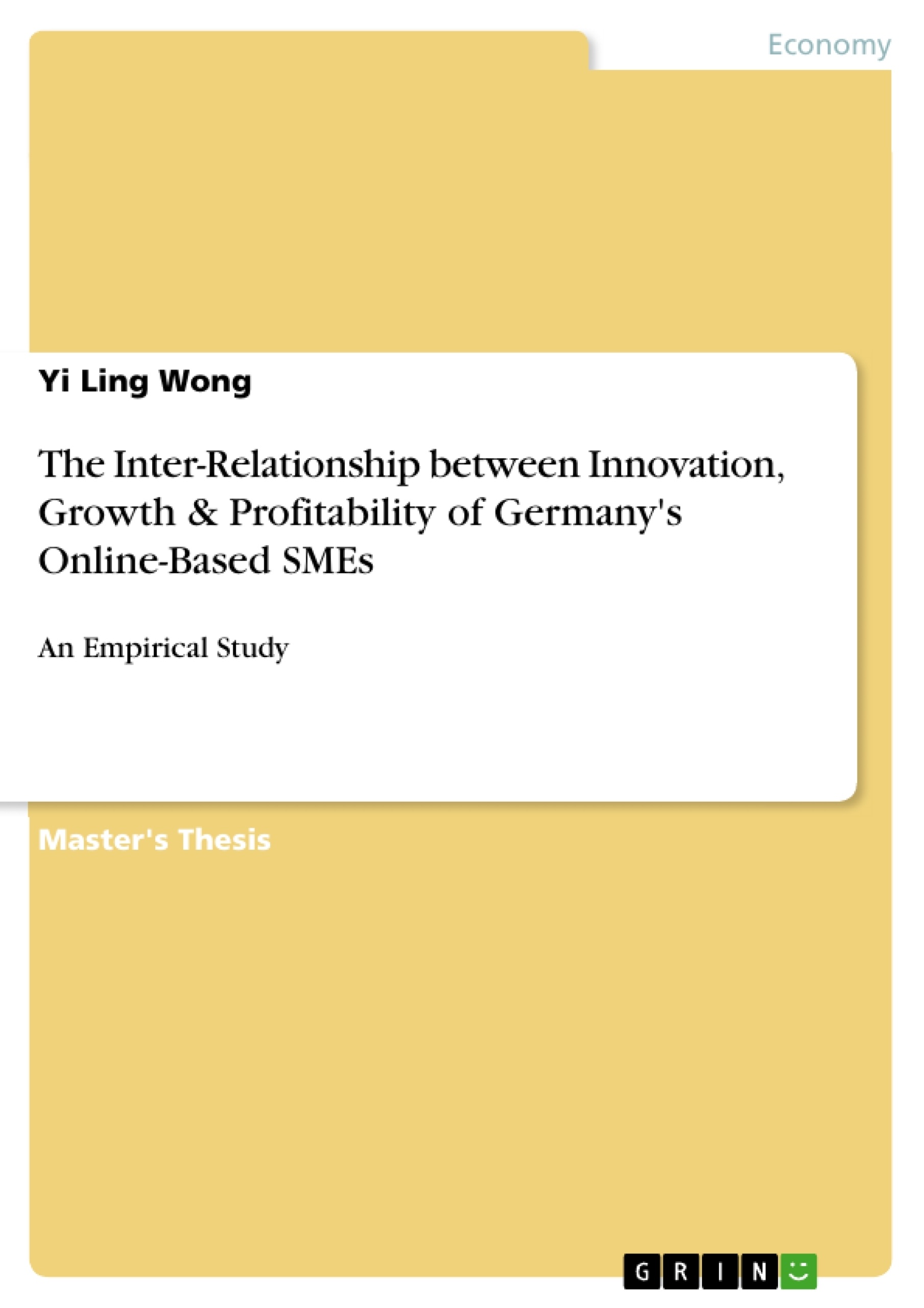This research aims to understand how innovation affects and is affected by a firm’s financial performance. It focuses particularly on the Internet industry and collects both quantitative and qualitative data from online-based SMEs in Germany. The results reveal that among online-businesses, the size of the company in terms of revenue is positively related to the level of innovation, whereas lower profitability and smaller absolute earnings seem to encourage higher levels of innovation. Companies with higher revenues are found to earn generally lower profit margins. It was also found that companies that experienced a reduction in annual revenue have a tendency to increase innovation levels. No significant effects were found between innovation levels and change in profitability. Similarly, no significant effects were found between change in profitability and growth. Among online-based SMEs, this study highlights the importance of innovation as an instrument employed by distressed companies to improve their performance. It also shows that there may be a tendency for the companies that are more profitable to focus less on innovation.
Inhaltsverzeichnis (Table of Contents)
- Abstract
- 1. Introduction
- 1.1 Research Problem
- 1.2 Research Questions and Objectives
- 1.3 Outline of the Thesis
- 2. Background
- 2.1 The Internet as a Platform for Business
- The Impacts on SMEs
- Rough History and some Drawbacks
- The Future: The Internet of Things
- Online-Based Business and Revenue Models
- 2.2 Internet Business in Germany
- The Online-based Company
- Current Situation in Germany
- SMEs in Germany
- 2.3 Definitions & Dimensions of Innovation in Online-based Businesses
- What is Innovation?
- Drivers of Innovation
- The Innovation Process
- Innovation Management for Success
- Innovation Types and Classifications
- 3. Literature Review & Hypotheses Development
- 3.1 Literature on Innovation-Size & Innovation-Profitability Relationships
- 3.2 Literature on Size-Profitability Relationship
- 3.3 Literature on Innovation-Growth & Innovation-Profitability Improvement Relationship
- 3.4 Literature on Growth - Change in Profitability Relationship
- 3.5 An Overview of Past Literature
- 4. Analytical Framework & Conceptual Model
- 4.1 Measurement Model
- Innovation
- Growth
- Profitability
- 5. Methodology
- 5.1 Mixed-methods Research
- 5.2 Quantitative Research through Online Survey
- Subjects and Participants
- Materials and Tools
- Design
- Procedure
- 5.3 Qualitative Research
- Participants
- Materials
- Design
- Procedure
- 6. Findings
- 6.1 Survey Data
- Graphical Representation of Collected Data
- 6.2 Summary of Regression Analysis
- Power and Sample Size Analysis
- 6.3 Interview Findings
- Expert Interviews
- Short Interviews
- 7. Analysis and Discussion
- 7.1 Theoretical Conclusions
- H1: Innovation-Size
- H2.1: Innovation-Profitability
- H2.2 Innovation-Earnings
- H3: Profitability-Size
- H4: Growth-Innovation
- H5: Change in Profitability-Innovation
- H6: Growth-Change in Profitability
- 7.2 Limitations
- 7.3 Recommendations for Further Study
- 8. Conclusion
- The relationship between innovation and company size in online-based SMEs.
- The impact of innovation on profitability and earnings in online-based SMEs.
- The influence of growth on the change in profitability of online-based SMEs.
- The role of the internet as a platform for business development and innovation within SMEs.
- The specific challenges and opportunities facing online-based SMEs in the German market.
Zielsetzung und Themenschwerpunkte (Objectives and Key Themes)
This thesis explores the interconnectedness between innovation, growth, and profitability among online-based SMEs in Germany. The study aims to empirically investigate how these factors influence each other and what implications they have for the long-term success of these businesses.
Zusammenfassung der Kapitel (Chapter Summaries)
The first chapter introduces the research problem, outlines the research questions and objectives, and provides a brief overview of the thesis structure. Chapter two delves into the background information, exploring the impact of the internet on SMEs and the specific context of online-based businesses in Germany. This chapter also defines and discusses various dimensions of innovation within the online business context.
Chapter three presents a comprehensive literature review, examining existing research on innovation-size, innovation-profitability, size-profitability, and growth-profitability relationships. This review lays the foundation for the development of hypotheses that are tested in the subsequent chapters. Chapter four outlines the analytical framework and conceptual model used in the study. It defines the key variables – innovation, growth, and profitability – and discusses the chosen measurement methods.
Chapter five details the methodology employed in the study, including a mixed-methods approach combining both quantitative and qualitative data collection methods. The quantitative research is conducted through an online survey, while qualitative data is gathered through expert interviews and short interviews with online-based SME owners. Chapter six presents the findings of the research, analyzing the data collected through the survey and interviews. This includes graphical representations of survey data and a summary of the regression analysis results.
Schlüsselwörter (Keywords)
This study focuses on the relationship between innovation, growth, and profitability in the context of online-based SMEs in Germany. It investigates key themes such as the role of the internet as a platform for business, innovation in online business models, the impact of company size on innovation, and the influence of innovation on profitability and earnings. The research employs both quantitative and qualitative methods, incorporating an online survey and expert interviews to gather data and analyze the relationships between these key variables.
- Citar trabajo
- Yi Ling Wong (Autor), 2014, The Inter-Relationship between Innovation, Growth & Profitability of Germany's Online-Based SMEs, Múnich, GRIN Verlag, https://www.grin.com/document/284157



